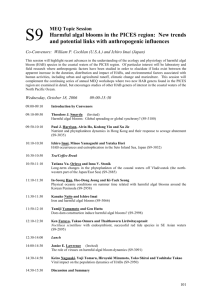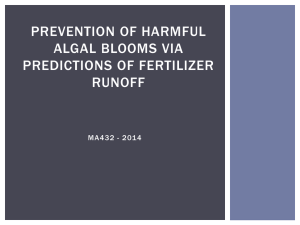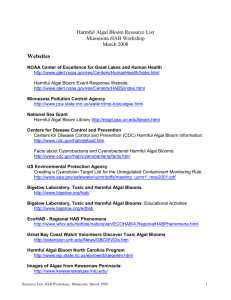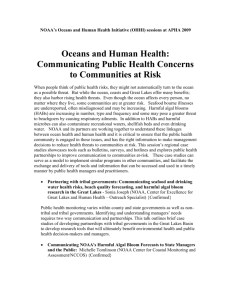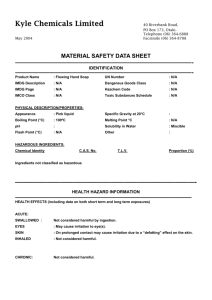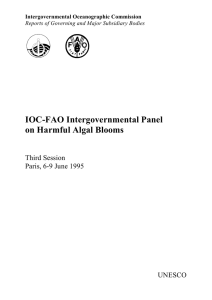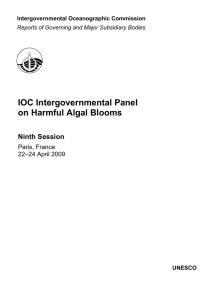Summary and Purpose of Document
advertisement
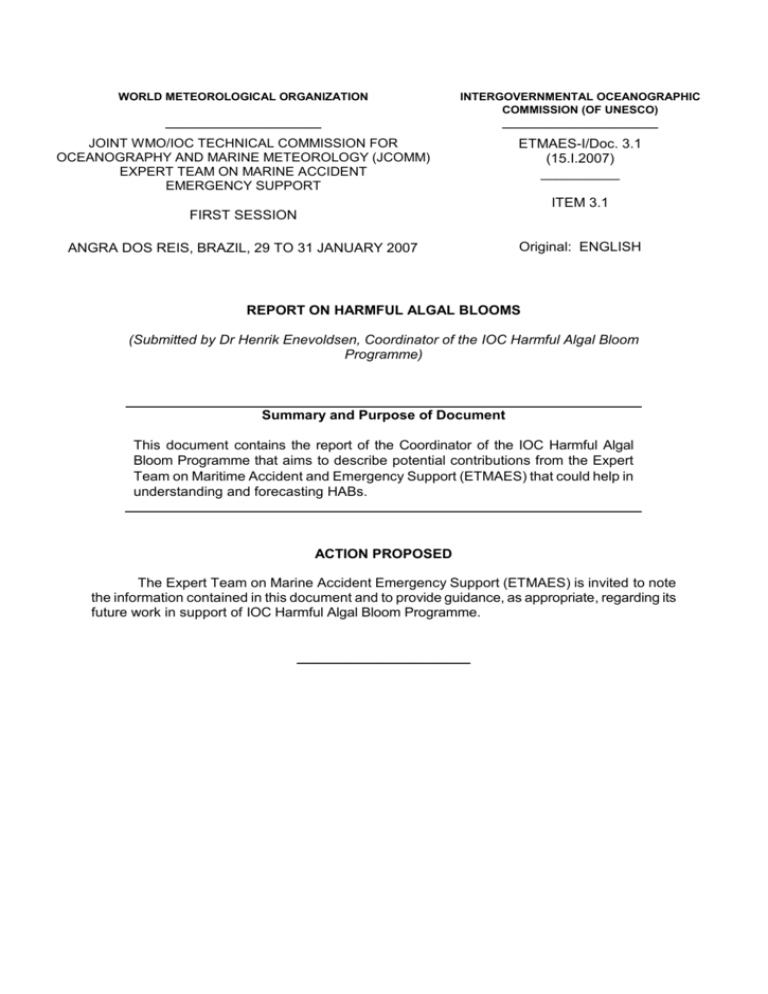
WORLD METEOROLOGICAL ORGANIZATION ________________________ INTERGOVERNMENTAL OCEANOGRAPHIC COMMISSION (OF UNESCO) ________________________ JOINT WMO/IOC TECHNICAL COMMISSION FOR OCEANOGRAPHY AND MARINE METEOROLOGY (JCOMM) EXPERT TEAM ON MARINE ACCIDENT EMERGENCY SUPPORT ETMAES-I/Doc. 3.1 (15.I.2007) __________ ITEM 3.1 FIRST SESSION ANGRA DOS REIS, BRAZIL, 29 TO 31 JANUARY 2007 Original: ENGLISH REPORT ON HARMFUL ALGAL BLOOMS (Submitted by Dr Henrik Enevoldsen, Coordinator of the IOC Harmful Algal Bloom Programme) Summary and Purpose of Document This document contains the report of the Coordinator of the IOC Harmful Algal Bloom Programme that aims to describe potential contributions from the Expert Team on Maritime Accident and Emergency Support (ETMAES) that could help in understanding and forecasting HABs. ACTION PROPOSED The Expert Team on Marine Accident Emergency Support (ETMAES) is invited to note the information contained in this document and to provide guidance, as appropriate, regarding its future work in support of IOC Harmful Algal Bloom Programme. ______________________ ETMAES-I/Doc. 3.1, p. 2 DISCUSSION 1. The proliferation of harmful phytoplankton in marine ecosystems can cause massive fish deaths, contaminate seafood with toxins, impact local and regional economies and dramatically affect ecological balance. Real-time observations are essential for effective short-term operational forecasting, but observation and modelling systems are under development. 2. There is widespread interest throughout the world in the installation of ocean observation systems to provide the data and knowledge needed to detect and forecast physical, chemical and biological changes in coastal and open-ocean ecosystems. Recent advances in instrumentation, communications and modelling capabilities have led to the design of prototype real-time observation and prediction systems for coastal ecosystems. Important phenomena in coastal waters include flooding and coastal erosion, oxygen depletion due to eutrophication and harmful algal blooms (HABs). However, many of the new approaches are unfamiliar to potential users. Optical and chemical sensors are, for instance, increasingly used from various platforms. Effective use of these sensors does not necessarily require advanced technical training, but it does require knowledge of the underlying theoretical and technical principles such as: how to properly deploy these instruments, methods for processing data, approaches for interpreting the results within reasonable limits and how such results can be incorporated into different kinds of predictive models. 3. The majority of the monitoring and observation systems on harmful algae in operation (http://www.ioc.unesco.org/hab/data2.htm#1) are strictly set up to protect a given resource (cultured finfish, cultured or wild shellfish, public health, etc.). This is reflected in a variety of approaches in chosen methodology and parameters, all dependent on the system (hydrographical regime, harmful species, resource, etc.) to be protected. Some systems deliver continuous data sets of great research value, while other have very abrupt time series as field observations are only made when triggered by secondary parameter (e.g., algal toxins in processed shellfish) or warnings from adjacent areas. Most management action in relation to harmful algal events is thus based on sets of system specific data. The international parameters that are providing reference for the design of specific HAB observation systems are in most cases the regional (EU, APEC and USFDA) regulations on tolerance levels of marine bio-toxins in food products and associated guidelines for levels of harmful micro-algae in the water under observation. The regional/national regulations have, as common reference, the WHO/FAO Codex Committee on Fish and Fishery Products (CCFFP). The IOC has published guidelines for design and implementation of HAB monitoring systems, Monitoring and Management Strategies for Harmful Algal Blooms in Coastal Waters, by D. M. Anderson, P. Andersen, V. M. Bricelj, J. J. Cullen and J. E. Rensel1. This 268-page report provides a broad review of the many programs, technologies, and policies used worldwide in the monitoring and management of harmful algal blooms in coastal waters. A PDF version of the Table of Contents is available at the following web address: http://www.whoi.edu/redtide/Monitoring_Mgt_Report.html. 4. Shortly, the IOC-UNESCO will publish a ‘UNESCO Monographs on Oceanographic Methodology’: Real-time Coastal Observing Systems for Marine Ecosystem Dynamics and Harmful Algal Blooms: Theory, Instrumentation and Modelling, edited by Marcel Babin, Collin Roesler and John Cullen. This volume offers guidance for developing real-time and near realtime sensing systems for observing and predicting plankton dynamics, including harmful algal blooms, in coastal waters. It explains the underlying theory and discusses current directions in research and monitoring in looking at instrumentation and modelling. Topics treated include: coastal ecosystems and dynamics of harmful algal blooms; theory and practical applications of in situ and remotely sensed optical detection of micro-algal distributions and composition; theory and practical applications of in situ biological and chemical sensors for targeted species and 1 APEC Report # 201-MR-01.1, Asia Pacific Economic Programme, and Intergovernmental Oceanographic Commission of UNESCO, Technical Series No. 59, Paris, France, 2001. ETMAES-I/Doc. 3.1, p. 3 toxin detection; integrated observing systems and platforms for detection; diagnostic and predictive modelling of ecosystems and harmful algal blooms, including data assimilation techniques; observational needs for the public and government; and future directions for research and operations. This anthology should inform the work of researchers and environmental monitors as well as teachers and trainers concerned with understanding the causes, predicting the occurrences and mitigating the effects of harmful algal blooms in marine ecosystems. 5. The Scientific Steering Committee for the IOC-SCOR science programme GEOHAB (Global Ecology and Oceanography of Harmful Algal Blooms, www.geohab.info) wishes to address the inclusion of, and approach to, observation systems for harmful algal events and harmful algal occurrences in regional GOOS components. 6. In some national or regional observing systems, HAB applications have been invoked as a major justification for such observing systems. However, in most cases it appears that only little of the observing infrastructure is specific to HABs. Clearly, information about temperature and velocity is extraordinarily useful for HAB applications, but this information alone is not enough for what is needed for qualified forecasts. 7. The GEOHAB SSC wish to facilitate the IOC Member States in making measurements that could help in understanding and forecasting HABs. The role of the GEOHAB could be to recommend systems that are as close as possible to operational use. The best candidates at the moment are ocean colour remote-sensing, fluorometers on ferries, etc. An inventory of available technology will help here and the SSC is currently working on said information. In situ flowcytomers (i.e., cytobuoy) and cell imaging systems (e.g., flowcam) are in transition to become operational but still need few years of proofing. There are certainly other candidates and this is an area that needs focus. Information exchange between the HAB and marine observation community is very important to stay up-to-date with observing system developments and to interact actively in development of operational systems for routine HAB observations. 8. If data from an observation systems (plankton sampling, probes, RS, hydrography, wind, etc.) indicate that plankton concentration or toxin levels get close to regulatory limits, management action will be to ban the harvesting of shellfish, move fish cages, close beaches or other actions. Models and forecasts can help by giving earlier and more qualified warnings so management actions can be timed more appropriately. This will have major economic impact in the sectors of society affected by harmful algal events, as there are always high costs associated with closing of harvesting, disturbance of sales markets, etc. 9. The IOC Intergovernmental Panel on Harmful Algal Blooms (IPHAB), during its Eighth Session, from 17 to 20 April 2007, an agenda to discuss and adopt a more proactive strategy to assist the IOC Member States in making measurements that could help in understanding and forecasting HABs. The IPHAB has invited the GOOS RA’s for a dialogue in this respect, and also welcome a dialogue with JCOMM on how this process can be accelerated through joint and coordinated action. _____________
